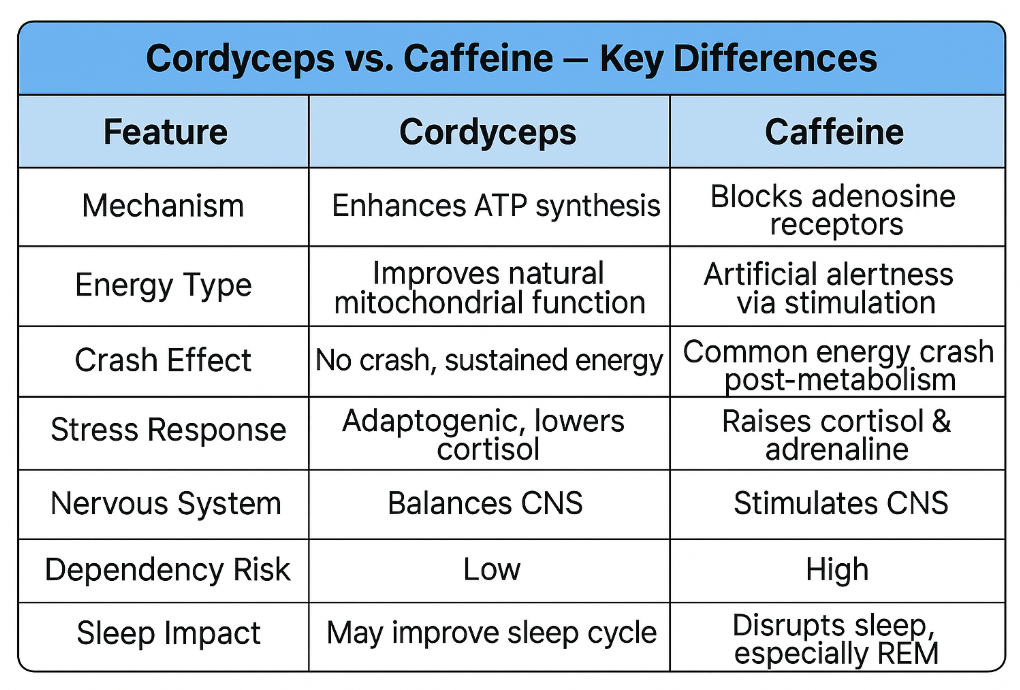Whys is Cordyceps better than Caffeine? It’s all about ATP
🔬 What is ATP? (Adenosine Triphosphate)
ATP is often referred to as the "energy currency" of the cell. It's a nucleotide composed of three components:
Adenine – a nitrogenous base
Ribose – a 5-carbon sugar
Three phosphate groups – linked by high-energy bonds
The energy stored in ATP resides primarily in the bonds between these phosphate groups, especially the last two phosphate bonds (called phosphoanhydride bonds). Breaking these bonds (usually the third phosphate) releases energy that cells use for almost every vital function.
⚙️ How Cells Use ATP
ATP powers nearly every cellular process. Here’s how:
1. Muscle Contraction
Myosin motors use ATP to contract muscle fibers.
2. Active Transport
ATP fuels pumps in the cell membrane (like the sodium-potassium pump) to maintain ion gradients.
3. Synthesis Reactions
DNA replication, RNA transcription, and protein synthesis all require ATP.
4. Signal Transduction
ATP donates phosphate groups to proteins (via kinases) to regulate cell signaling.
5. Cellular Maintenance
ATP supports processes like organelle movement, cellular respiration, and repair.
When ATP loses one phosphate group, it becomes ADP (adenosine diphosphate). It can also lose two to become AMP (adenosine monophosphate). These can be recycled back into ATP using energy derived from food (mainly glucose and fatty acids).
🔄 Where ATP Comes From
Cells produce ATP via three main pathways:
1. Glycolysis (in the cytoplasm)
Anaerobic (does not require oxygen)
Breaks glucose → pyruvate
Yields 2 ATP per glucose
2. Citric Acid Cycle (Krebs Cycle) and Oxidative Phosphorylation (in mitochondria)
Aerobic (requires oxygen)
Breaks down pyruvate/fats → CO₂ + H₂O
Yields ~34 ATP per glucose
3. β-Oxidation of Fatty Acids
Long-term energy, primarily during rest or fasting
High ATP yield per molecule of fat (e.g., palmitic acid yields ~129 ATP)
😴 Why Adenosine Makes Us Feel Tired
Adenosine is a byproduct of ATP breakdown. As ATP is used throughout the day:
ATP → ADP → AMP → Adenosine
Adenosine builds up in the brain, particularly in the basal forebrain, which regulates wakefulness and sleep.
It binds to adenosine receptors (especially A1 and A2A) on neurons, inhibiting neural activity.
This inhibition slows brain activity and promotes feelings of drowsiness.
High adenosine signals to the brain that the body has used a lot of energy — a biological marker for energy depletion.
⬆️ Transmission to the Brain
Adenosine doesn't need to be “transmitted” — it accumulates directly in the brain from ATP use in neurons and glial cells.
Brain cells sense this increase via adenosine receptors.
Once we sleep, adenosine is cleared, and alertness returns.
⚡ Why Cordyceps Provides "Clean Energy" vs. Caffeine
Cordyceps (especially Cordyceps militaris and Cordyceps sinensis) are fungi with adaptogenic and ergogenic properties.
📌 Cordyceps and ATP
Cordyceps may increase cellular ATP production by:
Improving oxygen utilization at the cellular level
Enhancing mitochondrial efficiency
Upregulating enzymes involved in aerobic respiration
Active compounds like cordycepin (3'-deoxyadenosine) mimic adenosine and may support nucleotide metabolism.
🚴♂️ Scientific Support
Studies in mice and humans show improved VO₂ max, endurance, and fatigue resistance.
Cordyceps extracts may also increase AMPK activity, which signals energy scarcity and stimulates mitochondrial biogenesis — helping cells create more ATP over time.
🧠 Summary in Plain Terms
ATP is the fuel every cell uses, and when it breaks down, it leaves behind adenosine.
As adenosine builds up, it tells your brain you're tired — like your body's natural “low battery” signal.
Caffeine works by blocking this signal, tricking your brain into feeling alert.
Cordyceps helps your body make more ATP, addressing the root cause of low energy without blocking important signals. That’s why it's often considered “clean energy.”

